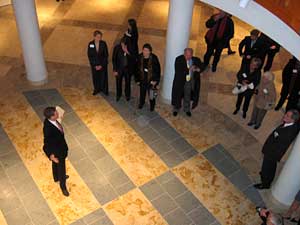|
Audio
Photos
Resources
|
 |
| MIA President Bill Griswold shows a group of visitors the atrium in the institute's new wing. The $50 million expansion will open next June. (MPR photo/Euan KErr) |
Minneapolis, Minn. — MIA President Bill Griswold had a determined look as he made his way through the throng of students filling the institute's entrance hall. It was partly the effort needed to get through, but mainly because he has a big project to complete.
Griswold led a group of visitors out across the chilly courtyard, stopping near the door to the MIA's new wing. He pointed out how the limestone lines of the Michael Graves design reflect the massive columns of MIA's famous facade.
"I think we should go inside and warm up a little bit," he said as the wind picked up, "and you can get a sense of the space on the ground floor."
A lot of this $50 million expansion is about big. Griswold talks about dozens of new galleries, as well as classrooms, preservation labs, archives and library stacks, and a large reception hall.
A few steps take the crowd inside to a huge sunlit space, still ringing with the sound of construction. The interior is awash in the muted tones of polished stone, and the warmer colors of maple panels. Griswold stands in the center and points to the roof.
"The centerpiece, of course, is this extraordinary three-story atrium which rises through two floors of galleries," he says. Bill Griswold never seems to take a breath as he talks. He's been in this job only a few months, but he's filled with information about how this new building will allow the MIA to develop and expand its mission.
"At the conclusion of this project we will have 34 new galleries, and 40 percent more space dedicated to the permanent collection," says Griswold.
Among all the numbers, Griswold also reveals the thinking going on behind the creation of a modern museum space.
The MIA has about 100,000 objects in its collection, ranging from ancient artifacts to modern photography. It can only show only a fraction of what it has at one time, and even with the new space it will be able to display only about 10 percent of its holdings.
The new wing means some specialized collections will have new expanded galleries. The MIA is essentially re-hanging the entire museum as it moves things around.
As the tour continues, Griswold causes a little bit of a stir with one sentence.
"This wing will be used primarily, or in large part, for the display of our 20th century collections."
The MIA has always been famous for its Asian art and its antiquities. But 20th century art?
There are a couple of motives here. MIA staff say they need to beef up that part of the institute's collection.
Half of the money from the MIA's $100 million capital campaign is to buy art. This makes the MIA more competitive in the international art market. MIA staff say they are open to all opportunities, but they will be focusing on purchasing 20th century work.
They point out that 70 percent of American art collectors focus on the 20th century. People like to see the kind of things they collect in museums. Frankly, building a relationship with collectors by having pictures they want to see, could lead to more works being donated to the MIA.
Griswold hands the tour-leading duties to curator Bob Jacobson, who takes the group up one floor. There he reveals another surprising idea -- there's not going to be a lot of "shushing" going on at the new MIA.
Jacobson says museums now are trying to encourage visitors' interaction, particularly in the atrium areas.
"There will be art on the walls, certainly, and some sculpture out. But, by and large, there will also be seating -- perhaps more seating than we are accustomed to -- perhaps because we are finding that people will sit, they will converse if you allow it to happen," Jacobson says.
The tour visits a large reception room with a stunning vaulted ceiling. This too is for interaction, banquets and sponsored events catered by the adjoining kitchen.
But there is one more surprise on entering the galleries themselves. They look very much like all the other galleries in the existing MIA -- plain walls with a simple unobtrusive baseboard. Jacobson says the idea is to integrate the new space, and make it easier for visitors to move between the old and the new.
The Minneapolis Institute of Arts opens its new wing on June 11, 2006.








